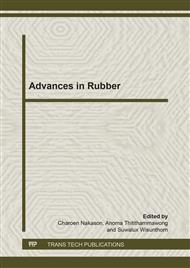p.305
p.309
p.314
p.318
p.322
p.326
p.330
p.334
p.338
Carbon Nanotube Elastomer Composites
Abstract:
Composites of multi walled carbon nanotubes and several synthetic rubbers as well as natural rubber were investigated regarding their mechanical properties, electrical and thermal conductivity and vulcanization properties. The composites were prepared by a melt mixing process. Induction and cure times obtained from rheometer curves exhibited a considerable decrease with increasing filler loading and kinetic investigations using a first order model indicated a distinct reduction of the activation energy. An examination of the crosslink density by equilibrium swelling and hysteresis tensile testing showed a strong increase with carbon nanotube content. The analysis of the thermal conductivity revealed the presents of a considerable interfacial thermal resistance which restricts the contribution of carbon nanotubes to the composite thermal conductivity. The electrical percolation thresholds of the melt compounded composites depend on processing procedure as well as elastomer and CNT type. At least a partial exfoliation of the CNT aggregates was reached.
Info:
Periodical:
Pages:
322-325
Citation:
Online since:
November 2013
Authors:
Keywords:
Price:
Сopyright:
© 2014 Trans Tech Publications Ltd. All Rights Reserved
Share:
Citation:


